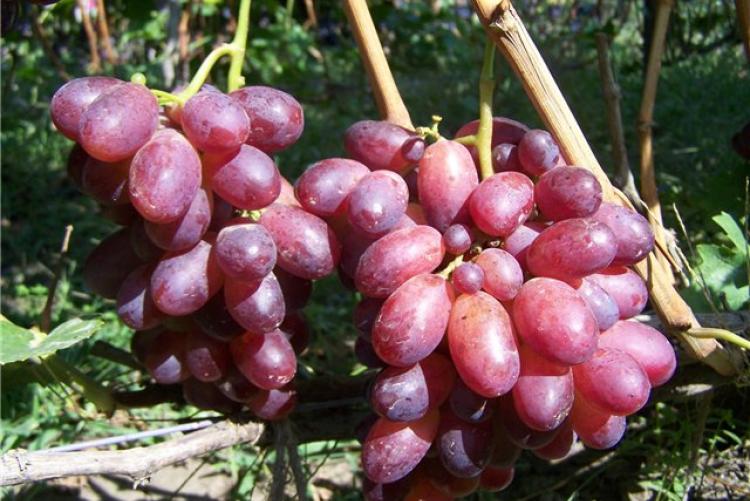
A dozen are mid-early table grapes that are easy to grow in their area. The hybrid (ZOS-1 and Rizamat + SP) was bred in 2007 by Lugansk amateur gardener Kitaichenko Alexander Ivanovich. Characteristic features of the variety are resistance to frost, undemanding, high productivity and unusual, pleasant taste of berries.
Content
Description of a dozen grapes
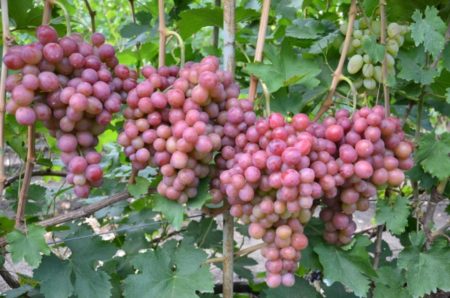
From the beginning of the growing season to harvesting, 120-130 days pass, in the middle lane the berries ripen closer to the second half of August. The species is rarely affected by culture-specific diseases, ailments can appear only in epidemic years. Berries practically do not damage wasps and sparrows. Frost resistance up to 23 degrees, and subject to snowy winters rises to 25.
Characteristics of the bush and berries
The height of an adult bush is about 4 meters, the shoots are strong, mature well during the growing season. The root is powerful, branched, rooting of cuttings is excellent. A dozen begin to bear fruit in the second or third year after planting. 3-4 brushes are formed on fruit vines, the bush does not withstand such a load, normalization is required. It is advisable to leave no more than 2 clusters on each branch.
The flowers are functionally female, while pollination is very good, stable without planting auxiliary varieties. The clusters are conical or cylindrical-conical, broad-shouldered, from 500 grams to two kilograms or more, the average density of the brush. The berries are oval or rounded, sometimes slightly flattened, from 12 to 20 grams. The color is very saturated and bright, raspberry red with a lilac hue and a fairly dense wax coating.
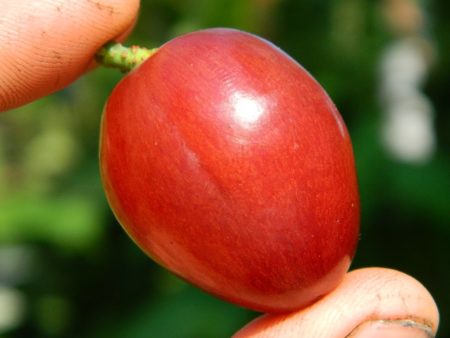
The flesh is crisp, juicy, the skin is dense, it is felt when eating, but does not interfere. There are 4 seed chambers, berries with two seeds are often found, grains are medium in size. The taste is rich, full-bodied, balanced honey-flower, there is no nutmeg in taste and aroma. The unique taste of the Dozen grape is manifested only when grown in an open, sunny place.
Productivity and Use
With the correct formation of the bush, an adult plant gives up to 100 kg of crop in one season, many gardeners share great indicators. However, there are those whose bushes begin to bear fruit only at the age of 4 or 5, and the signal brushes are small. The problem lies in non-compliance with the rules of agricultural technology, and not in the hybrid itself. Most often, the variety is grown for fresh consumption, berries are suitable for desserts. Fruits are often used for the preparation of juices, preserves and various fruit and berry assortments.
Advantages and disadvantages
The variety is endowed with very good characteristics, which have been checked and confirmed by winegrowers from Ukraine, Russia, Moldova and Belarus. Growing problems arise only in regions with cold and short summers, as well as in areas where winters are mostly snowless. Hybrid Features:
- high growth force of the bush;
- good ripening of the vine;
- productivity;
- frost resistance;
- resistance to diseases and pests;
- high marketability of brushes and berries;
- fruits at full ripening do not crack and practically do not crumble;
- good pollination;
- lack of peeling;
- transportability and keeping quality (up to 2 months);
- Dozen cuttings have a high survival rate.
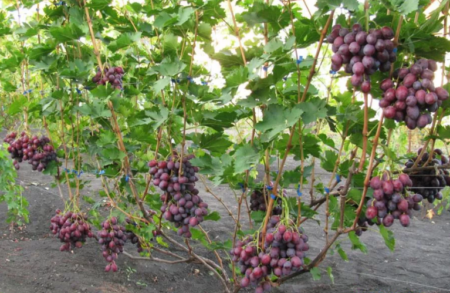
It should be noted one more advantage of the Dozen grapes - the bush can be planted in any convenient way, it is not necessary to prepare a large pit, fill it with a nutritious mixture. When planting by a simplified method, (in a normal hole for the size of the rhizome of a seedling), dressing will have to be carried out from the first year, and when planting in a prepared hole, fertilizers can be applied after the fruiting begins.
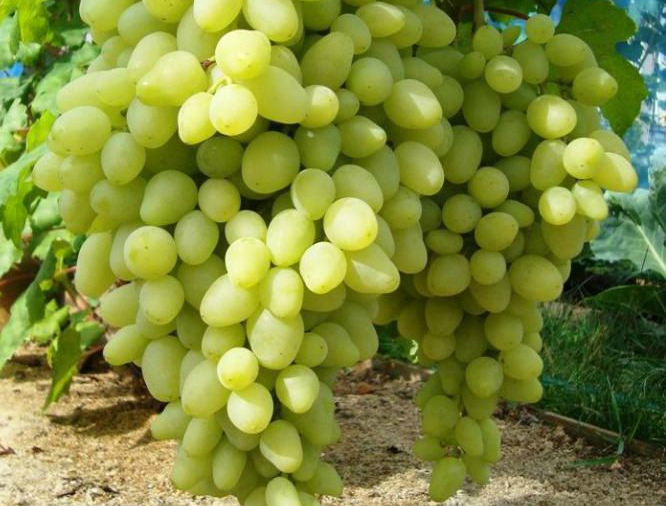
Long-awaited grapes: characteristics and description of the variety
When choosing a new variety for their plot, each gardener should study well all the characteristics of grapes and ...
Growing Features
When choosing a seedling, make sure that the root is branched, without dry or damaged areas. The color of the stem should be light brown, and in the context of brownish green. A place for the Dozen grapes should be allocated windless, closed from cold drafts and always sunny, the hybrid does not bear fruit well even in a light shade.
The soil on the site should be loose and permeable, the bush will not develop in places with a high level of groundwater. The support structure should be considered immediately when planting, as the bushes develop very quickly, they need to be tied up in a timely manner. You can plant a hybrid in the fall (until mid-October) and in the spring after the last return frosts. Let’s describe the best way to plant a dozen grapes:
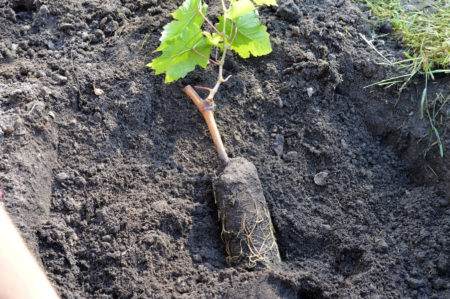
- dig a hole measuring 80x80 cm;
- pour a layer of rubble or gravel at the bottom (up to 20 cm);
- pour on a drainage layer of soil mixed with organic matter (compost or mullein);
- in the middle of the hole place a seedling, next to it drive a peg, cover it with the rest of the earth on the root neck;
- slightly tighten the ground, tie the stem to the peg, water the bush (2-3 buckets of water).
After 2 or 3 days after planting, mulch the soil around the seedling with rotted sawdust or dry mowed grass. In the first year after planting, cover the bush for the winter, this is a prerequisite for any region, even for the south. Drive a few pegs around the seedling, cover them with polyethylene, cover them with leaves or cover the bush with bulk containers and completely cover it with earth. When cultivating varieties in the southern or central regions harbor vines for the winter after the beginning of fruiting is not necessary.
Watering and feeding
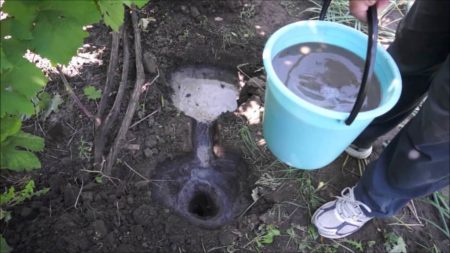
Watering should be carried out several times during the entire growing season: before flowering, at the very beginning of flowering, during the period of mass fruit loading and 10-15 days before harvesting. You need to feed the fruiting bush according to a certain scheme.
| Period | Fertilizers |
| Early spring, after the opening of the bushes, when the daytime temperature is set at 16 degrees. | 20 grams of superphosphate, 5 grams of potassium salt, 10 grams of ammonium nitrate per bucket of water or a kilogram of manure for the same amount of liquid. Pour at least 10 liters of fertilizer under each bush. |
| Before flowering. | Dilute 2 kg of mullein in 5 liters of water, leave to insist for 2-3 days. Bring the resulting mixture to 12 liters, this amount of fertilizer is enough for a square meter of grape planting. In the same period, you can carry out foliar top dressing - 5 grams boric acid on a bucket of water. |
| Before the formation of ovaries. | 10 grams of Kalimagnesia, 20 grams of ammonium nitrate per 10 liters of water. |
| 2-3 weeks before harvest. | 20 grams of superphosphate and potassium fertilizer (without chlorine) per bucket of water. |
| After leaf fall, before shelter. | During this period, the bushes need to be fed with organic matter - 2 kilograms of rotted manure under the bush, can be applied in dry and in liquid form. |
Disease protection
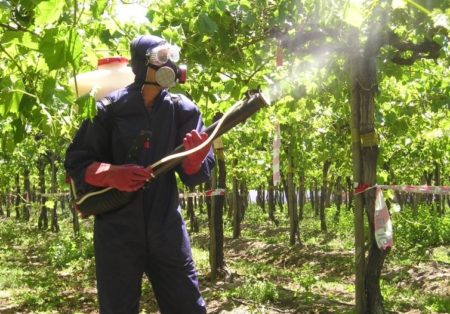
Many gardeners, grape growing A dozen not carry out preventive sprayingHowever, experts advise nevertheless to carry out 2 treatments against fungi - as soon as the green shoots reach a length of ten centimeters and after harvesting the entire crop, before leaf fall. Spray the bushes with a one percent solution of Bordeaux fluid, copper chloroxide or colloidal sulfur.
Pruning
You can form a bush according to any convenient scheme, with annual autumn pruned branches shorten by 6-8 eyes. In the spring, non-overwintered, dry, excess shoots that thicken the crown are cut. Clean up extra stepchildren during the summer season. For a more even ripening of berries, tear off the leaves shading them, but make sure that the fruits do not bake in the sun.
As you can see, a dozen grapes are very unpretentious, it requires minimal care, which is a big plus for beginners and for those who can not often go to the country. The hybrid is suitable for cultivation in small areas and large industrial plantations. The taste and aroma of a Dozen is unique; it can be recognized among a huge variety of other varieties.
Reviews
Kristina
She planted a dozen specifically for food, bought at the market, I really liked the unusual taste. I did not believe that the hybrid is really simple and undemanding, but it turned out to be so. Fertilized bush the year after planting, there were 8 large brushes. A dozen grows very quickly, the vine is already 7 years old, the productivity is high, but without normalization, the brushes are smaller. I carry out prevention only in the spring, I do not cover the bush, wintering without major losses (Volgograd).
Maksim
I have a Dozen on a stock, apparently because of this cluster there is always not more than a kilogram, there is a nutmeg in taste. Next year I plan to plant a root of my own bush, I really like the original taste of the hybrid. The neighbor grows the variety for sale, they are dismantled immediately, apparently attracting the appearance of the brushes and the rich, beautiful color of the berries. There were no diseases for 5 years of cultivation; I spend treatment in spring and autumn. After leaf fall, I feed the bushes with ash.




 Non-covering winter-hardy grape varieties for Moscow region
Non-covering winter-hardy grape varieties for Moscow region How to keep the vine in winter
How to keep the vine in winter When can I transfer grapes to another place in the fall
When can I transfer grapes to another place in the fall How to cover and prepare grapes for the winter in the suburbs
How to cover and prepare grapes for the winter in the suburbs